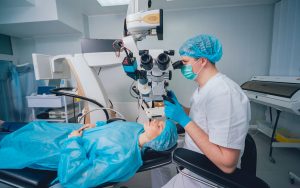What is Intralase LASIK, and How Does it Work?

IntraLase LASIK treatment is a blade-free process that uses lasers in vision correction procedures. The laser is used to create what is known as a corneal flap.
Before this revolutionary eye procedure, you had to do the operation manually using an oscillating metal blade known as a microkeratome. Luckily, the many advancements in medicine have given rise to tech that makes things a little less scary.
Intralase LASIK (also known as iLASIK) treatment is an outpatient medical procedure with a low risk of serious complications and high accuracy.
Unlike traditional LASIK, iLASIK uses waterfront tech to map the affected eyes and create the corneal flap using an Intralase laser. Some of the visual complications iLASIK corrects include; Astigmatism (imperfect corneal curvature), Hyperopia (farsightedness), and Myopia (near-sightedness).
Intralase LASIK is a speedy medical procedure that takes 20-30 minutes to correct vision in both eyes.
How Does iLASIK Work?
Every person’s eyes are different. Intralase LASIK customizes one’s eye treatment based on specific needs. The steps involved in the iLASIK procedure include the following:
Mapping Vision
Your eye specialist will use wavefront tech to make 3D maps of the eyes. With this kind of technology, the eye doctor will be able to identify the eyes’ specific characteristics with high accuracy.
Wavefront technology customizes vision treatment using the information it collects. It also controls the device that reshapes the cornea using laser beams known as the excimer laser.
Creating the Flap
After your doctor has made a custom diagnosis, they will use an Intralase laser to make the thin flap. This advanced femtosecond laser machine provides rapid laser light pulses which create bubbles under your cornea.
The laser can cut the corneal flap and size it into the proper diameter, shape, and thickness. It also makes perfect hinge locations. The place with the layer of bubbles allows the doctor to lift the thin flap and then fold it back so they can perform wavefront-based vision correction.
Wavefront Technology Laser Treatment
This corneal treatment procedure is the same as what you will find in traditional LASIK treatment. However, this part is computer-driven in iLASIK. Using the information collected during the mapping process, the wavefront tech directs the excimer device to reshape the cornea.
The excimer laser can tell the difference between your left and right iris, helping reduce the risk of wrong eye surgery. After the treatment, the doctor will reposition your corneal flap to start healing.
Traditional LASIK vs Intralase LASIK
Intralase LASIK surgery is an upgrade of traditional LASIK. Even though both kinds of LASIK surgery are safe, iLASIK is less invasive, yields more accurate results, and has a quicker healing time.
During traditional LASIK procedures, your doctor will use a microkeratome to create a corneal flap, allowing them to access the cornea better so they can reshape it using a specialized laser.
While this procedure is safe, the microkeratome is less accurate than its Intralase laser counterpart. Unlike traditional LASIK treatments, which use sharp tiny blades to make incisions in your cornea, the iLASIK procedure is blade-free and guided by wavefront tech.
This tech helps make the corneal flap creation procedure more accurate and easier. In addition, it gets rid of complications like postoperative astigmatism. Such issues occur more often in traditional LASIK procedures.
How much one sees is determined by their higher-order and lower-order aberrations. Lower-order aberrations are commonly referred to as refractive errors. These include astigmatism, farsightedness, and near-sightedness.
How well one can see is determined by higher-order aberrations. These abnormalities can cause halos, glares, and poor night vision. They also affect normal vision.
Traditional LASIK treatment can only effectively rectify lower-order aberrations. Its higher-order counterparts are harder to correct with standard LASIK. Intralase LASIK procedure, however, can treat other aberrations. Those who undergo this eye treatment need fewer enhancement procedures than traditional LASIK.
Advantages of IntraLase LASIK
- Improved Safety- Helps eliminate serious microkeratome-related problems, including button-hole flaps and invasive corneal incisions.
- Better Vision- Patients get statistically better overall vision when the doctor uses Intralase LASIK. Compared to the microkeratome-based LASIK treatment, more people get 20/20 vision after the procedure.
- High Degree of Accuracy and Predictability- Micron-level precision via the laser will help create significantly more accurate and predictable flap dimensions. This increased level of precision will allow the doctor to preserve valuable corneal tissue and improve the whole process’s predictability.
- Reduced Dry Eye Symptoms- In numerous clinical studies, the standard medical exams used to diagnose dry eye syndrome show a considerable reduction in symptoms. This reduced risk of dry eyes might be because of the typically thinner and uniform corneal flap, which creates less nerve disruption in one’s cornea.
- Fewer Retreatments- The number of LASIK enhancements or retreatments is much lower for corneal flaps created using a laser. It helps avoid the inconvenience of increased surgeon costs and subsequent surgeries that accompany retreatments.
The Takeaway
iLASIK is more precise and less intrusive than traditional LASIK. So, if the idea of a metal blade makes you nervous, then speak to your physician about Intralase LASIK. Ensure that you meet eligibility requirements and that the doctor offers enough insight into the surgery.
Our establishment has qualified ophthalmologists who can determine LASIK eligibility, among other factors.
In addition, we offer eye health care and advice to safeguard your vision. When you notice cloudiness, eye pain, and redness, visit our establishment for diagnosis and treatment.
Age macular degeneration and cataracts often start like this and can lead to complete vision loss. Faster treatment means a better chance of recovery or slowing down the process. Book your appointment today for an accurate diagnosis and good LASIK results.




